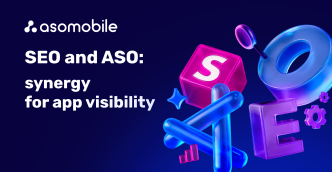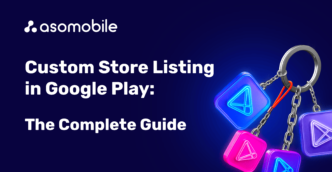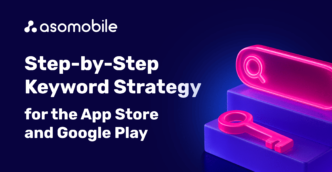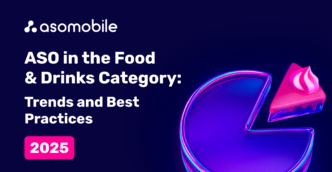Google Play Market & Apple App Store: evolution since 2008 to nowadays
Google Play Market platform evolution
Date of birth - 10/22/2008
Google announced the opening of an online platform for Android-based applications - the Android Market.

The main condition was to split the profit of 70 by 30 in favor of the developer, with 30% going to services and maintenance, and Google not to receive any profit from the sale of applications.
02/13/2009
Android Market is starting to accept paid apps, but only from US and UK developers. By the end of the year, this opportunity was given to developers in most countries of the world.
2010-2011
Applications had to be searched only through the category filter and nothing else. At the end of July 2010, 100 thousand apps were available in the store. Android Market contained several dozen programs, and all of them were free (there was no possibility of purchasing applications at that time).
The service for the sale of e-books - Google eBookstore was opened. This is followed by the opening of the Google Music site and support for books and movie rentals in the US Android Market.
In July, it was reported that users of Android smartphones completed over 1 billion downloads of applications stored on the Android Market.
2011
New service - video rental. Users will be able to rent movies for $ 1.99.
Moving from 2010 to 2011 was a huge change for the store. A prelude to what was to come next year with the Google Play Store name and design change. The presence of so many different sites introduced some confusion in the minds of users, which led to a completely logical step - an all-in-one, to combine all sites into one.
Google representatives said that 400,000 Android devices are connected in the world every day. In 2011, the store was almost completely reformed, and at that moment it showed the best free and most popular paid apps more clearly. Also, unlike in previous years, it was already possible to perform a specific search from the store's own search bar.
2012
The all-in-one strategy for the Google Play Market was launched this year - now books, films, and apps could be found and downloaded on one single site.
In March 2012, a new product appeared - Google Play Market, a direct competitor to iTunes.

The feature of the new product was “cloud shopping”, which provided the user with access to all purchases and installations when changing devices (new phone or switching to a tablet). Similar apps and apps that were installed by users after downloading appeared on the list.
Google Play launched in March with 450,000 Android apps and millions of music tracks and books and thousands of movies. In addition, this site served as a store for buying devices from Google - for example, Nexus smartphones.
Google Play surpassed 22 billion downloads in 2012.
2013 - 2014
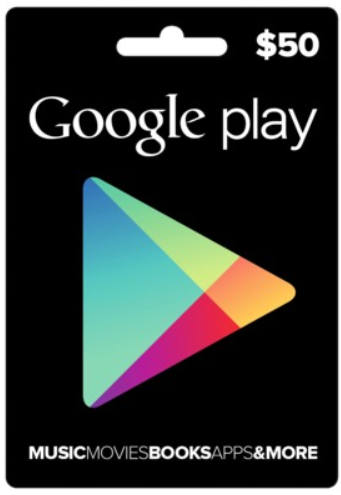
In early 2013, physical gift cards were released to the market so that users who did not want to use their bank card to purchase apps could receive them through the gift card. As of the end of the year, $ 26 million in revenue was generated, of which 17% came from in-app purchases.
Google has made significant changes to its guidelines for publishing apps on Google Play. They relate to app descriptions, ads, in-app purchases, ratings, and more. According to the rules, "applications may not contain a fake or incomprehensible description in any column, including the title, label, description, and screenshots."
In 2014 applications on the Google Play store got additional information about file size and rating. Also that year the entire store was redesigned and was given a general Android concept - Material Design.
The first victories: in two years after the merger and launch of a single platform, the number of applications grew to 1.5 million compared to 1.2 million ones on the App Store. Google Play became the leader in terms of the number of downloads - 51% of all downloads are made from it, where users prefer free and shareware apps.
In 2014, the number of apps on Google Play doubled. The most popular category is Games, followed by Photography, third by Music, fourth by Business, and fifth by Entertainment.
2015
The Play Market turned exclusively into digital content - the purchase of real devices was excluded from the store, moving it to another location. The store itself underwent some changes in the structure - new sections were allocated, thus there were "Applications and Games", "Entertainment" and so on.
App verification is also being introduced - starting that year, applications began to undergo moderation by staff, which included checking age restrictions.
Start of A / B testing in the developer console.
Results of 2015: Google Play overtook the App Store in terms of the number of apps but still lags behind in the revenue category.
2016 - 2017
2016 was the year of evolution for Google Play icons - now all related applications got a similar look, more familiar to us now.

There also waы an increase in the availability of apps on Chromebooks.
A section “Trending” appeared, which covered the most popular applications and games.
The Family Library was presented: family access to paid apps appeared, which can be shared within the family. In Google Play Family Library, you can share almost everything, excluding music - you are not able to distribute it due to copyright
2017: 2.77 million apps and games are available to download on Google Play. And this is without taking into account the number of films, TV series, music, books, and magazines also available on the site.
Google Play started flagging apps containing ads. New categories were added such as "dating", "cars" and others. On the other hand, Google began to identify fraudulent methods such as fake installs, promotions and began to punish apps using these methods.
A new revenue model was introduced for subscriptions: developers receive 85% of the revenue, which is a big change from 70% in previous years.
2017 was the year of changes in the developer console, the "Google Play Console" appeared.
Another important step was the change in search algorithms, for example, it began to take into account the user's interaction with the app after its installation.
Finally, at the end of 2017, Google launched Google Play Protect. This launch was a step forward in protecting users from malware-containing applications.
2018 - 2019
2018 was a pretty calm year in the evolution of the market. One of the significant events was informing the user about whether the apps of interest to him were found and in which collections they could be found.
The platform continued to fight against malware - applications using QR codes and crypto miners were under scrutiny.
2019 was a year of changes and many new features.
Depending on the categories, an application could be assigned tags (up to 5 tags) to make it easier for the user to find them.
Custom lists appeared in the developer console, a maximum of 5 and you could use them for more than one country. It was created with the aim of optimizing and localizing the application for the geographic and cultural characteristics of different countries.
The approach for calculating the average rating of an app is changing - the last rating has the greatest weight.
On April 17, 2019, it became know that Google made changes to the Play Store security policies, thanks to which developers of malicious Android applications were longer able to publish their products on the store - each application had to undergo a complex security review and testing.
Finally, in September 2019, app listing ads started being played automatically in the listing as well as in some search results.
2020
It became a year of a more personalized approach to user requests - the static and unified app store interface was being changed and became dynamic. More and more, the user behavior and preferences affect the appearance of the Google Play page - the apps that were already installed on the device, the search queries that were implemented in the market, all those affected the formation of recommendations from Google Play.
News of 2020: Epic Games sued Apple and Google for removing Fortnite from app stores, which caused quite a stir and drew a lot of attention to store commission issues and their relationship with developers.
On March 19, 2020, it became known that Google began to block the installation of apps on mobile Android devices if they were downloaded from outside the Google Play store.
2021

The year brought a decrease in the commission for developers from 30 to 15% (not for everyone, of course, a list of requirements for both applications and content was announced).
A separate “Policies and Programs” section was created to ensure simple and straightforward compliance with requirements and regulations.
New Google Play SDK Console: Prompt notification to developers about SDK issues.
Changes to Google Play policy for app metadata, including app visuals.
Android App Bundle: This allows you to optimize the size compared to the standard APK.
Expanding Payment Options: 34 new local forms of payment on 30 markets were added worldwide.
At the end of the article, you can find a 40% discount coupon for the first month of using ASOMobile - a tool for creating ASO and researching competitors in the mobile app market.
Apple App Store: evolution since 2008 to nowadays
We got to know all the main milestones in the development of the Google Play Market, now let's turn our attention to how its main competitor, the App Store, developed.
Date of birth - July 10, 2008
The appearance of this store was announced in March 2008 and in July the App Store appeared with 500 applications available. We remind you that Google Play was announced in August under the name Android Market and was launched in October.
2008
The results of the first months were stunning - just a month after the launch, more than 60 million downloads were made and two months after launch, 3,000 applications were available and 100 million downloads were already made.

What is interesting is the top popular apps for this period:
- Pandora Radio
- Tap tap revenge
- Shazam

2009
A year of growth, evolution, and improvement.
On April, 1 billion app installs were reached, with a total of 35,000 apps in the store. Compared to the Android Market, which at that time had only 2,300 apps.
App Store availability at that time was 77 countries.
IOS 3 is out with Find My iPhone, Safari improvements, and more text management.
Push notifications - that has become a real godsend for developers and marketers, with the ability to remind the user of an application that is not currently being used.
By the end of the year, the number of downloads, apps, and developers in the App Store had doubled.
The total cost of all applications in the Apple AppStore is 144,326 USD.
2010
App sales were $ 1.7 billion.
According to the British IHS report, the most popular mobile app store is the App Store - its market share was 83% of total revenues (in 2010 - $ 1.7 billion; in 2009 - $ 769 million)
In comparison, Android Market became the second in the number of apps, the range of which in December 2010 exceeded 200 thousand items with 2.5 billion installations.
June 2010 was the start of iOS 4 with the ability to create application folders and multi-zone. The famous iAD platform was also launched, which allowed developers to embed ads into their applications for the possibility of additional income.

2011
At the beginning of the year, the App Store has more than 350 thousand apps in its arsenal with availability in 90 countries of the world. The entire store is divided into categories: games, business, news, health, reference materials, and travel.
Announced 160 million iOS users with over 10 billion app downloads.
But despite the outstanding performance, 2011 was a year of losses for Apple. In October in Palo Alto at the age of 56, Steve Jobs, the founder, and mastermind, passed away.
IOS 5 comes out this year with the famous "iMessage", but no news for developers.
The competitor Android Market, meanwhile, was growing at a rapid pace, slowly but surely catching up with the App Store.
2012
By the end of 2012, the App Store had become the leader in so-called direct revenues, which include revenues from paid applications, in-app sales, and revenues from subscription services - 3.45 billion euros (out of the total mobile apps market of 5.1 billion euros).
But what is new besides achievements? It was this year that Store Recommendations finally appeared - such categories as App of the week, Editor’s choice, etc.
Thus, users could get familiar with new applications, and developers tried to get into favorites. That brought an expansion of the user base, installations, and, accordingly, income.
In 2012, Apple changed its App Store search algorithm, and search results began to be influenced by user ratings and keywords that were used in the App Name metadata field.
The release of iOS 6 introduced us to the Maps (before that the most used application was Google Maps), Passbook (the current Wallet), a new design of the App Store, and much more.
And one of the most important updates - Apple presented a section for recommendations called “genius” and a slower search method, which displayed information about the application, thus forcing the developer to come to grips with ASO of application optimizations.

2013
This year became a landmark and was marked by the release of the famous iOS 7 with a new notification center, AirDrop, and AirPlay. Apple changed the algorithm of its app store again - which boosted and increased attention to the optimization of the app.
The number of apps downloaded by App Store users has reached 50,000 million, while Google Play has more than doubled (102,000 million app downloads).
In general, a comparison of the App Store and Google Play that year showed interesting results:
Market share: Google Play Market - 74.4% vs App Store - 18.2%. But! Daily Income: Google Play Market - $ 1.1M vs App Store - $ 5.1M

2014
The changes that started the previous year were continued. And it is the search algorithms. If before that time the user had to enter a search query in full to form search results, then from that moment the Intended search function was launched. Thanks to that, in addition to the search results, it was possible to see related search queries.
These changes led to significant changes in ASO optimization, increased understanding of search algorithms, and improved work with semantics - app keywords.
The new release of iOS 8 brought some improvements and new features such as Community Interactive Notifications. Since then, you can reply to a message directly from the notification. The Tap to Talk feature was announced, which allows you to send voice messages, videos, and photos.
The App Store has started showing a preview of the listing in the store. This gave app developers even more ways to reach their audience and focus their efforts on ASO optimization.
Also that year the presentation of “the most personalized gadget in the world” - the Apple Watch - was held.
2015
Improvements and evolution of the App Store search algorithm.
There were 2 pieces of news about the App Store: the introduction of the Shopping category in the store and a change in the new algorithm. That year can be considered the year of the creation of the current search algorithm. Let's dwell on this in more detail. After all, it was then that the indexing of applications began to take place according to the now well-known scheme - a combination of keywords from metadata fields.
iOS 9. Maps now support public transportation, the Notes app lets you capture ideas in new ways, and the News app selects content based on your interests
Apple Music, the revolutionary music streaming service, was launched.
2016
The most significant event of that year was the launch of Apple Search Ads since the attempt to win the favor of the developers with the previous iAD service was not crowned with success. That is why Apple scrapped this project and tried again. And they presented Apple Search Ads, their own App Store advertising platform, on which you can promote your app in the search section by common keywords, brand keywords, or competitors, and appear in the top charts.
An update to the application metadata requirements reduced the App Name field from 225 to 50 characters.
Also this year there was a big purge of content - in confirmation of its negative attitude towards outdated apps, the App Store decided to remove about 50,000 apps from its store by the end of the year.
iOS 10 - with a redesigned lock screen, limited third-party Siri support, an updated Maps app, and, of course, iMessage improvements.

2017
Changes to the App Store search algorithms were undergoing another change, which gives food for thought to ASO specialists.
And what was new was the ability to respond to user reviews right in the App Store Connect.
And as has already been highlighted, the annual update of the operating system marked the release of iOS 11. Users were given access to augmented reality applications and many photo effects.
With iOS 11, the App Store was completely updated to make finding apps and games easier than ever.
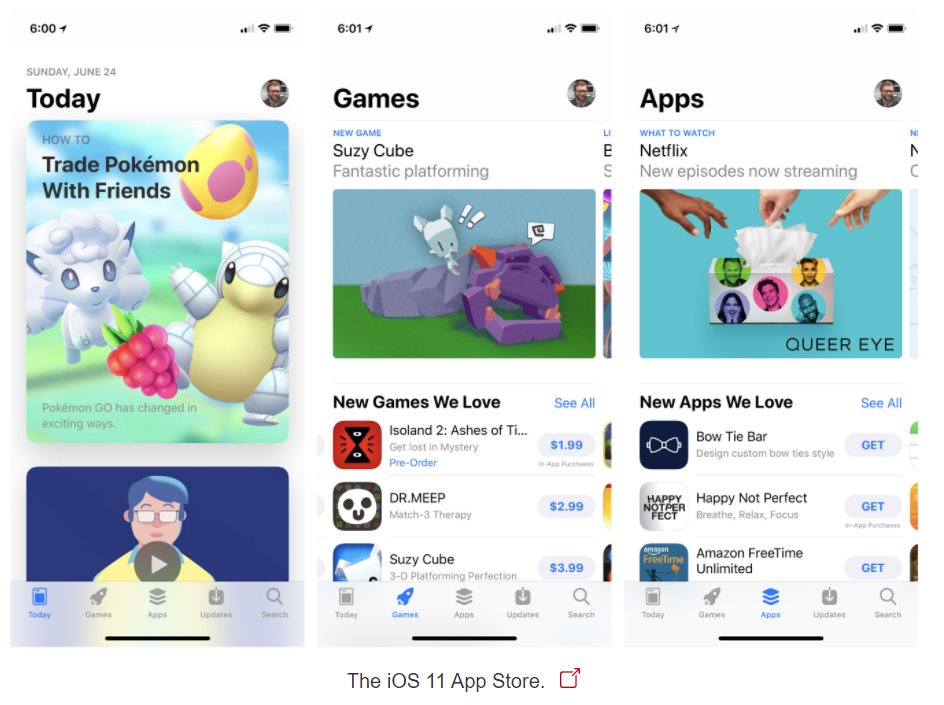
Metadata looked more and more familiar to us:
App Name: instead of 50 characters, only 30 were available, which left less room for optimization in this field.
Another news is that in Subtitle fields - 30 characters and Promotional Field - 170 characters were available for optimization.
In December 2017, Apple published several new rules for the App Store, detailing the policies and new requirements that developers had to comply with in order for their apps to be approved for hosting. Apple promises to make the Apple Developer Program free to governments and nonprofits starting in 2018.
App Annie estimated that from 2008, when the App Store was launched, to the end of 2017, app downloads reached 170 billion, and total user spending exceeded $ 130 billion.
2018
The events of that year were the ban on the publication by individuals of VPN applications for the iPhone and iPad. Also, the requirements for the protection and personal data storage of users became more strict.
At WWDC 2018, it was announced that over 10 years of the App Store's operation, developers who placed their applications and games there, earned more than $ 100 billion from them. The App Store, every week, is visited by over 500 million active users around the world. At the end of 2017, the number of applications decreased, which is understandable due to the tightening of requirements for applications.
But for ASO optimization, these years were remembered for changing the structure of the metadata fields that allowed the application to be indexed:
- The application name remained the most important field, with the same 30 characters available.
- The subtitle also remained an important field for optimization, as it was 30 characters long, which helped in ranking.
- The ad retained its 170 character structure, but it was no longer indexable for the App Store algorithm and became a field that mainly influenced the conversion rate.
- Keywords was a new field coming to App Store Connect, with 100 characters available and ready to serve as an add-on to existing fields for indexing the most important keywords.
- News items appeared that helped position the listing of the application in a specific language with support for other additional languages.
The release of iOS 12 brought users an improved system performance, new augmented reality capabilities, Memoji, and Screen Time on iPhone and iPad.
2019
The volume of payments and purchases through the App Store system in 2019 exceeded $ 519 billion. Developers in the App Store earn 64% more than in Google Play
Litigation: in May 2019, the US Supreme Court recognized the App Store as a monopoly and allowed users to file antitrust claims against the corporation.
iOS 13: Dark mode, enhanced photo and camera features, Apple sign-in, and completely redesigned Maps.
Apple is introducing the industry-leading Apple News + service for reading magazines and news, giving subscribers full, personalized access to over 300 titles right in the service.
2020
The App Store has more and more apps and featured apps customized for each user, leaving behind the static interface where all users see the same thing. All content is the result of the actions of the user themself, his choice, and interests. The dark mode increased the attractiveness of the interface. For ASO, another interesting point appears - more and more search queries by users are entered by voice typing, which must be taken into account when optimizing.
New app categories were added to the App Store: Developer Tools and Graphics & Design.
2020 was also the year that Apple made significant privacy-related changes with the release of iOS 14. The announcement shocked the industry, prompting Apple to delay its implementation until "early 2021."
New litigation - now between corporations and developer Epic Games.
2021
The most anticipated news for ASO specialists is the launch of A / B tests on iOS 15.
The App Store will allow you to A / B test the visuals of your app page to try and get better results and increase download conversions.
Also with iOS 15, it will be possible to create additional versions of the original product page and direct them to specific audiences using a unique URL. With the aim of:
- Create different product pages and load them regardless of the published version.
- Publish up to 35 product pages at a time.
- Monitor and analyze the data of each product page - views, impressions, downloads, conversion rates, etc.
In-app events are a great tool for expanding audience reach, as users can find out about them directly through the App Store.
App Store Widget and Game Center Widget - Includes developer stories and collections, and displays the Today tab, right on your screen.
But the year 2021 is still ongoing - we are waiting for news and we will keep you updated!
 Українська
Українська  Русский
Русский  Español
Español 
